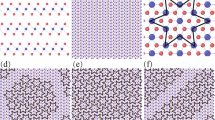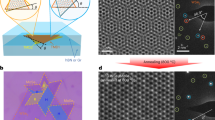Abstract
Nanoscale periodic moiré patterns, for example those formed at the interface of a twisted bilayer of two-dimensional materials, provide opportunities for engineering the electronic properties of van der Waals heterostructures1,2,3,4,5,6,7,8,9,10,11. In this work, we synthesized the epitaxial heterostructure of 1T-TiTe2/1T-TiSe2 with various twist angles using molecular beam epitaxy and investigated the moiré pattern induced/enhanced charge density wave (CDW) states with scanning tunnelling microscopy. When the twist angle is near zero degrees, 2 × 2 CDW domains are formed in 1T-TiTe2, separated by 1 × 1 normal state domains, and trapped in the moiré pattern. The formation of the moiré-trapped CDW state is ascribed to the local strain variation due to atomic reconstruction. Furthermore, this CDW state persists at room temperature, suggesting its potential for future CDW-based applications. Such moiré-trapped CDW patterns were not observed at larger twist angles. Our study paves the way for constructing metallic twist van der Waals bilayers and tuning many-body effects via moiré engineering.
This is a preview of subscription content, access via your institution
Access options
Access Nature and 54 other Nature Portfolio journals
Get Nature+, our best-value online-access subscription
$29.99 / 30 days
cancel any time
Subscribe to this journal
Receive 12 print issues and online access
$259.00 per year
only $21.58 per issue
Buy this article
- Purchase on Springer Link
- Instant access to full article PDF
Prices may be subject to local taxes which are calculated during checkout




Similar content being viewed by others
Data availability
The data supporting the findings of this study are available from the corresponding authors upon reasonable request.
References
Bistritzer, R. & MacDonald, A. H. Moiré bands in twisted double-layer graphene. Proc. Natl Acad. Sci. USA 108, 12233–12237 (2011).
Geim, A. K. & Grigorieva, I. V. Van der Waals heterostructures. Nature 499, 419–425 (2013).
Dean, C. R. et al. Hofstadter’s butterfly and the fractal quantum Hall effect in moiré superlattices. Nature 497, 598–602 (2013).
Hunt, B. et al. Massive Dirac fermions and Hofstadter butterfly in a van der Waals heterostructure. Science 340, 1427–1430 (2013).
Alden, J. S. et al. Strain solitons and topological defects in bilayer graphene. Proc. Natl Acad. Sci. USA 110, 11256–11260 (2013).
Tong, Q. J. et al. Topological mosaics in moiré superlattices of van der Waals heterobilayers. Nat. Phys. 13, 356–362 (2016).
Wu, F., Lovorn, T. & MacDonald, A. H. Topological exciton bands in moiré heterojunctions. Phys. Rev. Lett. 118, 147401 (2017).
Kim, K. et al. Tunable moiré bands and strong correlations in small-twist-angle bilayer graphene. Proc. Natl Acad. Sci. USA 114, 3364–3369 (2017).
Cao, Y. et al. Unconventional superconductivity in magic-angle graphene superlattices. Nature 556, 43–50 (2018).
Sharpe, A. L. et al. Emergent ferromagnetism near three-quarters filling in twisted bilayer graphene. Science 365, 605–608 (2019).
Tran, K. et al. Evidence for moiré excitons in van der Waals heterostructures. Nature 567, 71–75 (2019).
Morosan, E. et al. Superconductivity in CuxTiSe2. Nat. Phys. 2, 544–550 (2006).
Chen, P. et al. Charge density wave transition in single-layer titanium diselenide. Nat. Commun. 6, 8943 (2015).
Fazekas, P. & Tosatti, E. Electrical, structural and magnetic properties of pure and doped 1T-TaS2. Philos. Mag. B 39, 229–244 (1979).
Zhang, K. W. et al. Unveiling the charge density wave inhomogeneity and pseudogap state in 1T-TiSe2. Sci. Bull. 63, 426–432 (2018).
Chen, P. et al. Emergence of charge density waves and a pseudogap in single-layer TiTe2. Nat. Commun. 8, 516 (2017).
Weston, A. et al. Atomic reconstruction in twisted bilayers of transition metal dichalcogenides. Nat. Nanotechnol. 15, 592–597 (2020).
Yoo, H. et al. Atomic and electronic reconstruction at the van der Waals interface in twisted bilayer graphene. Nat. Mater. 18, 448–453 (2019).
Yao, Q. et al. Charge transfer effects in naturally occurring van der Waals heterostructures (PbSe)1.16(TiSe2)m (m = 1, 2). Phys. Rev. Lett. 120, 106401 (2018).
Lin, M. K. et al. Charge instability in single-layer TiTe2 mediated by van der Waals bonding to substrates. Phys. Rev. Lett. 125, 176405 (2020).
Guster, B., Robles, R., Pruneda, M., Canadell, E. & Ordejón, P. 2 × 2 charge density wave in single-layer TiTe2. 2D Mater. 6, 015027 (2018).
Hÿtch, M. J., Snoeck, E. & Kilaas, R. Quantitative measurement of displacement and strain fields from HREM micrographs. Ultramicroscopy 74, 131–146 (1998).
Lawler, M. J. et al. Intra-unit-cell electronic nematicity of the high-Tc copper-oxide pseudogap states. Nature 466, 347–351 (2010).
Walkup, D. et al. Interplay of orbital effects and nanoscale strain in topological crystalline insulators. Nat. Commun. 9, 1550 (2018).
Woods, C. R. et al. Commensurate–incommensurate transition in graphene on hexagonal boron nitride. Nat. Phys. 10, 451–456 (2014).
Rosenberger, M. R. et al. Twist angle-dependent atomic reconstruction and moiré patterns in transition metal dichalcogenide heterostructures. ACS Nano 14, 4550–4558 (2020).
Ritschel, T. et al. Orbital textures and charge density waves in transition metal dichalcogenides. Nat. Phys. 11, 328–331 (2015).
Lee, S.-H., Goh, J. S. & Cho, D. Origin of the insulating phase and first-order metal-insulator transition in 1T−TaS2. Phys. Rev. Lett. 122, 106404 (2019).
Stahl, Q. et al. Collapse of layer dimerization in the photo-induced hidden state of 1T-TaS2. Nat. Commun. 11, 1247 (2020).
Lin, M. K. et al. Coherent electronic band structure of TiTe2/TiSe2 moiré bilayer. ACS Nano 15, 3359–3364 (2021).
Kresse, G. & Hafner, J. Norm-conserving and ultrasoft pseudopotentials for first-row and transition elements. J. Phys. Condens. Matter 6, 8245–8257 (1994).
Kresse, G. & Joubert, D. From ultrasoft pseudopotentials to the projector augmented-wave method. Phys. Rev. B 59, 1758–1775 (1999).
Blochl, P. E. Projector augmented-wave method. Phys. Rev. B 50, 17953–17979 (1994).
Perdew, J. P., Burke, K. & Ernzerhof, M. Generalized gradient approximation made simple. Phys. Rev. Lett. 77, 3865–3868 (1996).
Grimme, S., Antony, J., Ehrlich, S. & Krieg, H. A consistent and accurate ab initio parametrization of density functional dispersion correction (DFT-D) for the 94 elements H-Pu. J. Chem. Phys. 132, 154104 (2010).
Medeiros, P. V. C., Stafström, S. & Björk, J. Effects of extrinsic and intrinsic perturbations on the electronic structure of graphene: retaining an effective primitive cell band structure by band unfolding. Phys. Rev. B 89, 041407(R) (2014).
Medeiros, P. V. C., Tsirkin, S. S., Stafström, S. & Björk, J. Unfolding spinor wave functions and expectation values of general operators: introducing the unfolding-density operator. Phys. Rev. B 91, 041116(R) (2015).
Acknowledgements
This work was financially supported by the National Natural Science Foundation of China. W.-M.Z., L.Z., Q.-Y.L., Q.-W.W., L.-G.D., J.-G.H. and S.-C.L. acknowledge the National Natural Science Foundation of China (grant nos 11774149 and 11790311). Z.N. and S.M. acknowledge the National Natural Science Foundation of China (grant nos 91850120, 11774328 and 11934003) and the Chinese Academy of Sciences (XDB330301).
Author information
Authors and Affiliations
Contributions
S.-C.L. conceived the project and designed the experiments. W.-M.Z. and L.Z. grew the epitaxial TiTe2/TiSe2 heterostructures and performed STM characterizations with the assistance of Q.-Y.L., Q.-W.W., L.-G.D. and J.-G.H.; S.-C.L. supervised the MBE growth and STM characterization. Z.N. performed the DFT calculations under the supervision of L.X. and S.M.; W.-M.Z., L.Z. and S.-C.L. wrote the manuscript with input and comments from all the authors.
Corresponding authors
Ethics declarations
Competing interests
The authors declare no competing interests.
Additional information
Peer review information Nature Materials thanks Jonas Bekaert and the other, anonymous, reviewer(s) for their contribution to the peer review of this work.
Publisher’s note Springer Nature remains neutral with regard to jurisdictional claims in published maps and institutional affiliations.
Supplementary information
Supplementary Information
Supplementary Figs. 1–16, Notes 1–4 and refs. 1–3.
Rights and permissions
About this article
Cite this article
Zhao, WM., Zhu, L., Nie, Z. et al. Moiré enhanced charge density wave state in twisted 1T-TiTe2/1T-TiSe2 heterostructures. Nat. Mater. 21, 284–289 (2022). https://doi.org/10.1038/s41563-021-01167-0
Received:
Accepted:
Published:
Issue Date:
DOI: https://doi.org/10.1038/s41563-021-01167-0
This article is cited by
-
Reconfiguring nucleation for CVD growth of twisted bilayer MoS2 with a wide range of twist angles
Nature Communications (2024)
-
Realization of large-area ultraflat chiral blue phosphorene
Nature Communications (2024)
-
Persistence of charge density wave against variation of band structures in VxTi1−xSe2(x = 0−0.1)
Nano Research (2024)
-
Topotactic fabrication of transition metal dichalcogenide superconducting nanocircuits
Nature Communications (2023)
-
Advance in two-dimensional twisted moiré materials: Fabrication, properties, and applications
Nano Research (2023)



